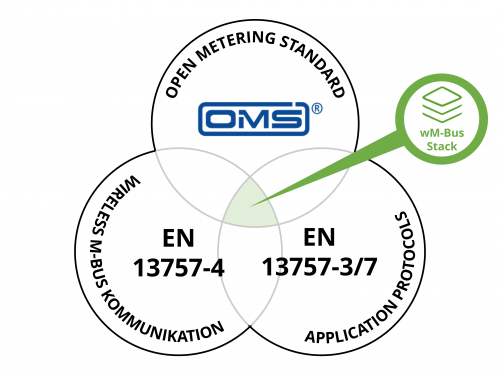Do you want competitive products that are easy to install and maintain? Then it is time for you to take a closer look at our Wireless M-Bus Protocol Stack. Characterized by low energy consumption and excellent modularity combined with high functionality, the Wireless M-Bus Stack is the ideal partner for Smart Metering, Sub-Metering or Smart City applications. Learn more about Stack features, implemented standards and the Stack Package in the article.
Stack Features
The Wireless M-Bus Stack implements seven layers:

By default we offer flexible interfaces such as an API for the application layer in single chip solutions, an API for externalization of security functions and a well designed Hardware Abstraction Layer (HAL). API for other layers e.g. Data Link Layer (DLL) are available on request. All API functions are alternatively available via an included serial interface implementation that supports UART, SPI and other ports and provides minimal overhead. For particularly sensitive applications, the serial interface offers the use of AES encryption methods, or additional options for encrypted serial communication are available upon request.
The Wireless M-Bus Stack can be operated in different modes. It is possible to choose between the modes S, T and C, as well as the direction - unidirectional or bidirectional - is freely selectable. The advantage of a switch within the compile time is the reduction of data, the switch during runtime guarantees flexibility in the field at any time.
In order to make use of only one hardware timer for all wireless M-Bus related timings, the stack can perform compensation for synchronous interval timing as well as automatically drop packets in case of a large mismatch.
Likewise, any type of read-only memory such as EEPROM, Flash or MRAM is supported. Flexible interfaces ensure easy adaptation and platform-specific optimization e.g. for hardware-supported AES decryption/encryption, CRC-16 or (de-) encoding of Manchester / 3-out-of-6.
Which standards does the stack implement?
The Wireless M-Bus Protocol Stack implementation covers a large part of the options and features specified in the European standard EN 13757 or its substandards. However, not all features have been implemented or integrated into the stack for commercial and maintenance reasons. We have taken into account the most common or, based on experience, most reasonable options and features, which we successively extend based on customer requests. Specifically, the Wireless M-Bus Stack implements the following standards:
The Wireless M-Bus Protocol Stack is an implementation of the European standards EN 13 757-3/-4/-7 and the OMS specification. The OMS specification is supported in version 4.2.1 at present, with development of version 4.3.3 currently underway and available in Q2/2022. Wireless communication is defined by the specification of part EN 13 757-4, allowing the stack to operate as a "Wireless" M-Bus. The stack allows operation for endpoints or meters, as well as for collectors or data concentrators according to these standards.
Other sub-standards such as DSMR, ESMR, CIG UNI/TS 11291-11-4 PM1, ... can be offered on request, but are currently not available in the Standard Stack Package.

If you are interested in one of the sub-standards, or a very specific implementation of EN 13757, we would be happy to discuss it with you. In most cases, however, it is advisable to rely on the common specification of the OMS, since years of development work and application experience have already gone into it. In this way, networks can be set up relatively easily and quickly. In addition to the frequencies and modes of EN 13757, the OMS also specifies the use of other frequency bands for the Middle East, Australia and other countries. This means that a reliable standard can also be used across national borders. Furthermore, the OMS group operates a certification procedure that ensures interoperability across manufacturers.
The Wireless M-Bus Stack package
The Wireless M-Bus Stack package is basically delivered with a precompiled stack library, hardware specific drivers, a serial interface, a power management and the two app folders "Example" and "Modem". Example includes an example for creating your own firmware. It shows how the stack library can be integrated into your own application software. The Modem app, on the other hand, can be used to create your own modem firmware using the supplied serial port and power management. Thus it is possible to implement both chip architectures with the supplied Protocol Stack package:
- To use the Protocol Stack within a One-Chip design (the Protocol Stack runs on the same microcontroller as the application), the App Example and thus only the stack library is required.
- If a Two-Chip design is followed (the Protocol Stack is to run on a communication controller and the application on a host controller), the App Modem can be accessed. This makes it possible to create your own firmware for the communication controller. The protocol stack is then accessed via the host controller.
With purchase of the Wireless M-Bus Stack you get the following accesses:
- Protocol Stack: Object code
- RF driver: object code
- HAL: source code
Also, 12 months of maintenance are basically part of the Wireless M-Bus Stack Package. Different license models define additional services such as support.
Read more about hardware requirements and product licensing in the second part of the article "Technical aspects of the Wireless M-Bus Stack".

